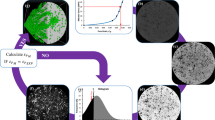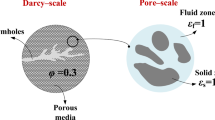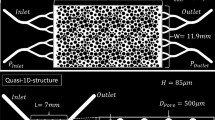Abstract
The dissolution of carbonate rocks usually leads to both porosity \((\phi )\) and permeability \((k)\) increase. We present experimental evidences and physical-based models of positive and anti-correlated dynamics of \(k\) and \(\phi \) observed during dissolution experiments of carbonate rocks. We study the way the rate of change of \(\phi \) and \(k\) is controlled by the degree of undersaturation of the percolating solution for two different types of carbonate rocks. We document the occurrence of an anti-correlated \(k-\phi \) trend when the flowing fluid (deionized water) has a weak capacity of dissolution. A positive correlation is found when \(\hbox {CO}_{2}\) is added to the deionized water to increase the potential dissolution rate. Detailed analyses of the microstructures of the rock performed by X-ray microtomography reveal that low dissolution rate favors detachment of solid particles and their subsequent accumulation at the pore-throat inlet. Particles are detached from the rock matrix due to the differential dissolution rate of the indurated grains and the microporous cement. We then propose a simple phenomenological model to interpret the effect of the pore-throat clogging by the accumulation of partially dissolved carbonate particles. We conjecture that permeability is controlled by the decrease of the effective hydraulic radius and the increase of the tortuosity due to partial and localized obstruction of the pore network. Conversely, increasing the level of undersaturation of the flowing solution leads to an augmented potential of dissolving most of the transported particles before they reach the throats. In this case, both \(k\) and \(\phi \) increase and display power-law correlations.















Similar content being viewed by others
References
Appelo, C.A.J., Postma, D.: Geochemistry Groundwater and Pollution. A.A. Balkema Publishers, Rotterdam (1993)
Athy, L.F.: Density, porosity, and compaction of sedimentary rocks. AAPG Bull. 14, 1–24 (1930)
Cohen, C., Ding, D., Quintard, M., Bazin, B.: From pore scale to wellbore scale: impact of geometry on wormhole growth in carbonate acidization. Chem. Eng. Sci. 63, 3088–3099 (2008)
Fan, Y., Durlofsky, L.J., Tchelepi, H.A.: A fully-coupled flow-reactive-transport formulation based on element conservation, with application to \(\text{ CO }_{2}\) storage simulations. Adv. Water Resour. 42, 47–61 (2012)
Garing, C.: Caractérisation géophysique et géochimique des interactions fluide-roche à l’interface eau douce-eau salée : cas des carbonates récifaux de Majorque. Ph.D. thesis, University of Montpellier 2, Montpellier, France (2011)
Garing, C., Luquot, L., Pezard, P.A., Gouze, P.: Electrical and flow properties of highly heterogeneous carbonate rocks. AAPG Bull. 98(1), 49–66 (2014)
Golfier, F., Zarcone, C., Bazin, V., Lenormand, R., Lasseux, D., Quintard, M.: Ability of a Darcy-scale model to capture wormhole formation during the dissolution of a porous medium. J. Fluid Mech. 457, 213–254 (2002)
Gouze, P., Luquot, L.: On the characterization of porosity–permeability relationships and reactive surface areas during heterogeneous dissolution induced by \(\text{ CO }_{2}\) injection in limestone reservoir. J. Contam. Hydrol. (2011). doi:10.1016/j.jconhyd.2010.07.004
Gouze, P., Noiriel, C., Bruderer, C., Loggia, D., Leprovost, R.: X-Ray tomography characterization of fracture surfaces during dissolution process. Geophys. Res. Lett. 30(5), 1267–1270 (2003)
Gouze, P., Melean, Y., Le Borgne, T., Dentz, M., Carrera, J.: Non-Fickian dispersion in porous media explained by heterogeneous microscale matrix diffusion. Water Resour. Res. (2008). doi:10.1029/2007WR006690
Hao, Y., Smith, M.M., Sholokhova, Y., Carroll, S.A.: \(\text{ CO }_{2}\)-induced dissolution of low permeability carbonates, part II: numerical modeling of experiments. Adv. Water Resour. 62, 388–408 (2013)
Hebert, V.: Analyses multi-echelles de la structure d’un reservoir carbonate littoral: Exemple de la plateforme de Llucmajor (Majorque, Espagne). Ph.D. thesis, University of Montpellier 2, Montpellier, France (2011)
Hebert, V., Garing, C., Luquot, L., Gouze, P.: Multi-scale X-ray tomography analysis of carbonate porosity. In: Agar, S.M., Geiger, S. (eds.) Geological Society. Special Publications, London (2014). doi:10.1144/SP406.12
Kalia, N., Balakotaiah, V.: Modeling and analysis of wormhole formation in reactive dissolution of carbonate rocks. Chem. Eng. Sci. 62(2007), 919–928 (2007)
Le Guen, Y., Hellmann, R., Collombet, M., Gratier, J.-P., Renard, F., Brosse, E.: Enhanced deformation of limestone and sandstone in the presence of high \(\text{ P }_{\rm CO_2}\) fluids. J. Geophys. Res. B: Solid Earth (2007). doi:10.1029/2006JB004637
Luquot, L., Gouze, P.: Experimental determination of porosity and permeability changes induced by massive injection of \(\text{ CO }_{2}\) into carbonate reservoirs. Chem. Geol. (2009). doi:10.1016/j.chemgeo.2009.03.028
Luquot, L., Rodriguez, O., Gouze, P.: Experimental characterization of porosity structure and transport property changes in limestone undergoing different dissolution regimes. Transp. Porous Media (2014). doi:10.1007/s11242-013-0257-4
Luhmann, A.J., Kong, X.-Z., Tutolo, B.M., Garapati, N., Bagley, B.C., Saar, M.O., Seyfried Jr, W.E.: Experimental dissolution of dolomite by \(\text{ CO }_{2}\)-charged brine at \(100\,^{\circ }\text{ C }\) and 150 bar: evolution of porosity, permeability, and reactive surface area. Chem. Geol. 380, 145–160 (2014)
Mangane, P.O., Gouze, P., Luquot, L.: Permeability impairment of a limestone reservoir triggered by heterogeneous dissolution and particles migration during \(\text{ CO }_{2}\)-rich injection. Geophys. Res. Lett. 40(17), 4614–4619 (2013)
Meijster, A., Roerdink, J.B.T.M., Hesselink, W.H.: A general algorithm for computing distance transforms in linear time, Computational imaging and vision. Mathematical Morphology and Its Application to Image and Signal Processing 18(8), 331–340 (2000)
Moore, C.H.: Carbonate reservoirs, porosity evolution and diagenesis in a sequence-stratigraphic frame-work. In: Developments in Sedimentology, vol. 55. pp. 1–444 (2001)
Noiriel, C., Bernard, D., Gouze, P., Thibault, X.: Hydraulic properties and microgeometry evolution accompanying limestone dissolution by acidic water. Oil Gas Sci. Technol. 60, 177–192 (2005)
Noiriel, C., Luquot, L., Madé, B., Raimbault, L., Gouze, P., Van Der Lee, J.: Changes in reactive surface area during dissolution process: an experimental and modelling study. Chem. Geol. (2009). doi:10.1016/j.chemgeo.2009.01.032
Parkhurst, D.L., Appelo, C.A.J.: User’s guide to PHREEQC (Version 2)—A computer program for speciation, batch-reaction, one-dimensional transport, and inverse geochemical calculations. US Geological Survey Water-Resources Investigations Report pp. 99–4259 (1999)
Pokrovsky, O.S., Golubev, S.V., Schott, J., Castillo, A.: Calcite, dolomite and magnesite dissolution kinetics in aqueous solutions at acid to circumneutral pH, 25 to \(150\,^{\circ }\text{ C }\) and 1 to 55 atm \(\text{ P }_{\rm CO_2}\): new constraints on \(\text{ CO }_2\)sequestration in sedimentary basins. Chem. Geol. 265, 20–32 (2009)
Qajar, J., Francois, N., Arns, C.H.: Microtomographic characterization of dissolution-induced local porosity changes including fines migration in carbonate rock. SPE J. 18(3), 545–562 (2013)
Rutqvist, J., Stephansson, O.: The role of hydromechanical coupling in fractured rock engineering. Hydrol. J. 11, 7–40 (2003)
Saaltink, M., Vilarrasa, V., de Gaspari, F., Silva, O., Carrera, J., Rötting, T.S.: A method for incorporating equilibrium chemicals reactions into multiphase flow models for \(\text{ CO }_{2}\) storage. Adv. Water Resour. 62, 431–441 (2013)
Sahimi, M.: Applications of Percolation Theory. CRC Press, Taylor & Francis, London (1994)
Schneider, F., Potdevin, J.L., Wolf, S., Faille, I.: Mechanical and chemical compaction model for sedimentary basin simulators. Tectonophysics 263, 307–313 (1996)
Siena, M., Guadagnini, A., Riva, M., Bijeljic, B., Pereira Nunes, J.P., Blunt, M.J.: Statistical scaling of pore-scale Lagrangian velocities in natural porous media. Phys. Rev. E. 90, 023013 (2014)
Smith, M.M., Sholokhova, Y., Hao, Y., Carroll, S.A.: \(\text{ CO }_{2}\)-induced dissolution of low permeability carbonates, part I: characterization and experiments. Adv. Water Resour. 62, 370–387 (2013)
Tutolo, B.M., Luhmann, A.J., Kong, X.-Z., Saar, M.O., Seyfried Jr, W.E.: Experimental observation of permeability changes in dolomite at \(\text{ CO }_{2}\) sequestration conditions. Environ. Sci. Technol. (2014). doi:10.1021/es4036946
Wang, X., Alvarado, V., Swoboda-Colberg, N., Kaszuba, J.P.: Reactivity of dolomite in water-saturated supercritical carbon dioxide: significance for carbon capture and storage and for enhanced oil and gas recovery. Energy Convers. Manag. 65, 564–573 (2013)
Acknowledgments
We wish to thank Dr Elodie Boller (European Synchrotron Radiation Facility, Grenoble, France) for her precious help in the data acquisition and Dr Linda Luquot for the many constructive discussions concerning the experimental protocol setup. This study was supported by the EU-funded project PANACEA (EU-7thFP—ENERGY 282900).
Author information
Authors and Affiliations
Corresponding author
Rights and permissions
About this article
Cite this article
Garing, C., Gouze, P., Kassab, M. et al. Anti-correlated Porosity–Permeability Changes During the Dissolution of Carbonate Rocks: Experimental Evidences and Modeling. Transp Porous Med 107, 595–621 (2015). https://doi.org/10.1007/s11242-015-0456-2
Received:
Accepted:
Published:
Issue Date:
DOI: https://doi.org/10.1007/s11242-015-0456-2




